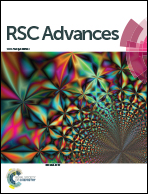Comparative cell adhesion properties of cysteine extended peptide architectures†
Abstract
This study presents the comparative cell attachment investigation of TAT and well-known RGD peptide modified surfaces. Initially, cysteine containing arginine–glycine–aspartic acid (RGD) and TAT peptides, a class of cell penetration peptides, were synthesized. Gold film coated indium tin oxide (gold/ITO) surfaces were coated with RGD and TAT peptides and used for cell culture applications. Thiol groups on the peptides provide post-modification of the surface. The efficient bonding of the peptides with the modified surface brings proper attachment of the cells. The peptide modified surfaces were tested for adhesion of several cell lines such as monkey kidney epithelial cell (Vero), human cervical carcinoma cell (HeLa), human glioblastoma cell (U87-MG) and human immortalized skin keratinocyte cell (HaCaT) lines. These cells were cultured on RGD and TAT modified gold/ITO surfaces. Cell imaging studies were performed on these surfaces using fluorescence microscopy technique. Scanning electron microscopy (SEM), atomic force microscopy (AFM), cyclic voltammetry (CV), electrochemical impedance spectroscopy (EIS), X-ray photoelectron spectroscopy (XPS) and contact angle measurements were carried out for the surface characterization. The results indicate that the RGD and TAT modified surfaces exhibited better cell adhesion. Therefore, besides RGD as a well-known adhesion peptide, TAT functionalized substrates were found to be efficient bio-sensing candidates for further studies.


 Please wait while we load your content...
Please wait while we load your content...